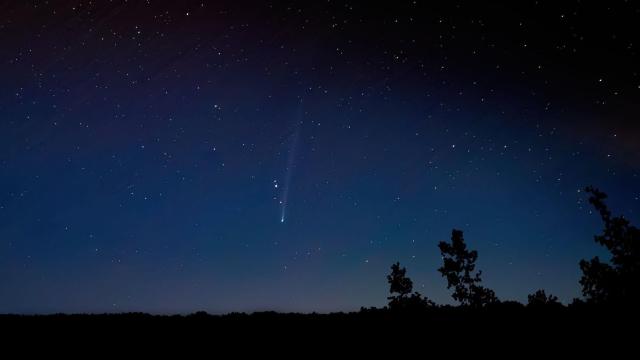Nishimura (2023 P1), a comet discovered just last month, is set to make its nearest approach to Earth in the next 400 years during tomorrow’s predawn sky.
Comets are frozen accumulations of rock, dust, and ices that grow tails when warmed up by objects like our Sun, occasionally making them stunning to behold in the night sky. Some comet tails can stretch millions of miles long, according to NASA.
The comet that may be visible tomorrow morning was discovered in early August by Hideo Nishimura, a space photographer and amateur astronomer, who captured the comet using a standard digital camera. It was Nishimura’s third comet discovery, after two observations in 2021 and 1994. Since then, the comet has brightened to the point that it may be visible to the naked eye.
Unfortunately, Nishimura (that is, 2023 P1, not its namesake discoverer) is angularly near the Sun, meaning it will only be visible around sunset and sunrise, according to NASA. The comet’s perihelion—its closest approach to the Sun—will occur on September 17, according to Sky & Telescope, which also states its peak brightness: potentially 2nd magnitude. Its closest approach to Earth will be tomorrow, when the comet will be about 78 million miles away, according to EarthSky.
An apparent brightness of magnitude 2 would put the comet in the same ballpark as the star Polaris—though that number does not account for the brightness of twilight and any atmospheric disturbances that could further obscure the comet from view. For comparison, the Sun has an apparent magnitude of -26.74, the planet Venus has an apparent magnitude of -4.6, and the naked eye can only see to about an apparent magnitude of 6. In other words, the comet will be quite faint, but if luck is on your side you’ll be able to see it with your eyes alone.
Sky & Telescope’s Bob King recommends being out two hours before sunrise in order to catch the comet in the predawn skies. The comet’s window of observation is expected to be about 20 minutes. As previously recommended by Gizmodo, stargazing apps like Starwalk or Sky Guide may be useful in determining what part of the sky to focus your naked-eye search for the comet.
Nishimura’s orbital period is about 435 years, meaning its next near-pass of our planet will be in 2458. But that’s assuming the comet survives swinging by the Sun, whose warmth may threaten the comet’s icy composition. In any case, your best bet to see the comet is tomorrow morning, unless you have an elixir of life recipe you’re keeping to yourself.
